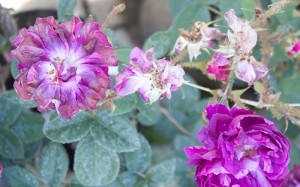Diary – July 2011
Now’s your last chance to sow biennials. ‘Brompton Stocks’ and ‘Forget me Nots’ are fast growing and can be sown later and slow growing ‘Canterbury Bells’ should be planted in late spring but the remainder need sowing now. Space them out well to reduced thinning and transplant to their flowering position in late autumn or spring. If flower buds appear before that, nip them out with your finger and thumb, you don’t want them producing flowers too early in the autumn instead of spring. Traditionally, they are sown in a separate seed bed, though a spare corner in the vegetable patch will do. Plants like Angelica gigas, which resent root disturbance, can be sown in pots or modules and carefully transplanted or sown where they are to flower.
Unless you’re growing plants for their ornamental seed heads or want to save the seed for the following year, ‘deadhead’ your plants to extend the flowering season. It prevents them from wasting energy producing unwanted seeds and stops those that self seed freely, like ‘Lady’s Mantle’ or ‘Love in a mist’ from becoming a problem weed. Hybrid Tea Roses were traditionally cut back as the flowers faded, to a strong outward facing bud, often well below the flower and cluster flowered roses were treated in a similar way, once the blooms were over. However, current thinking for both types, and indeed others, is that only a minimal amount of the stem should be removed keeping the maximum number of leaves on the plant to help with photosynthesis. Shrubs like Philadelphus and plants flowering now that bloom on wood produced the previous year, should have all the old flowering stems removed back to a strong, outward facing stem. It’s impossible to deadhead plants which produce masses of smaller flowers but they can be fed with a general fertiliser as a boost after flowering to help them recover and hanging basket plants like ‘Lobelia’ can be trimmed with shears, fed with general fertiliser until they recover and flowering boosted with high potash fertiliser. Don’t feed your woody plants after mid-August or the new growth will be damaged by early frosts.

Powdery mildew can cause problems at this time of year, too, particularly during dry periods. Look out for a white powdery coating on shoots stems and leaves, different species attack a range of hosts from Clematis to marrows, courgettes and peas to ‘Honeysuckle’ and Phlox. Keeping the soil moist by watering and mulching, will certainly reduce problems. Removing infected parts and clearing infected material at the end of the season helps, too, as does growing disease resistant plants or spraying with sulphur based sprays (Do this according to the manufacturer’s instructions and check that the plant is sulphur tolerant by spraying a small area first.) or use organic sprays based on fish and vegetable oils.
Remember to ventilate and damp down the greenhouse floor on hot days and to check plants in the greenhouse twice a day to ensure that they are well watered.
Happy Gardening! Matt


